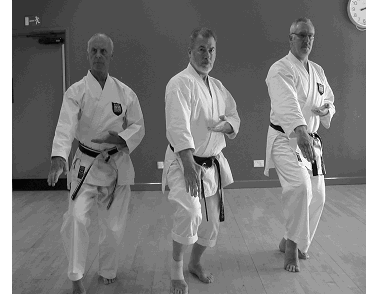|
Shihankai fellows meet for ‘senior moment’
On the 1st of September 2004, the Lancashire Health and Fitness Centre in Middleton near Manchester was the venue for four senior fellows and members of the International Shotokan-ryu Karate-do Shihankai’s (ISKS) technical committee to meet and train. The ISKS is made up of senior international Shotokan karateka of Godan and above, fellowship is through recommendation from or invitation by an existing ISKS fellow.
Sensei’s John Mullin 7th Dan Kyoshi, Executive Chairman of the World Traditional Karate Organisation (WTKO), Charles Gidley 7th Dan Kyoshi, Chief Instructor to the British Shotokan Kyogi International (BSKI), George Carruthers 7th Dan Kyoshi, BSKI Director (International Affairs) and Ged Moran 7th Dan Kyoshi BSKI Director (England and Wales) met for a training session. The session was organised to introduce kata to the three British Instructors which Asai sensei had taught, initially to his faction of the JKA, and latterly to the Japan Karate Shotokai. Charles Gidley had previously been introduced to the kata during his attendance at the WTKO championships in America, 2003.
The kata allegedly come from an old pool of Okinawan kata which Asai sensei uses in his personal training, some of which are from the Unsu family. New kata, outwith the 26 standard Shotokan kata are becoming more prevalently taught to yudansha in the dojo. Many of the Shotokan groups and their senior instructors aligned with high ranking Japanese instructors such as senseis Kanazawa and Kase, are being introduced to kata and practices outside, what some may view as the traditional teaching of the style. Whether this is good or bad is always open to argument but we do know that Funakoshi himself wished karate to remain dynamic. There is also the argument that the cache of Shotokan kata has grown over the years from 15 to the 26 we know now. However, there are those yudansha who are embracing these new kata and training regimes, not necessarily as part of their association’s/dojo’s training or teaching syllabus, but in order to achieve a greater personal understanding of the budo aspect of Shotokan karate as a fighting art rather than a sport.
 Sensei Mullin, who flew in to the UK from New York on business, initially went through four kata: KakeYoku Shodan the first of three in this series and Seusu, Kashu and Hachimon. These were expertly put on film by Ged Moran, of Legend Video fame, who was also kind enough to take time out from training to take the photograph. The training regimes and rationale behind the kata, e.g. improving balance on 360° turning, quick changes of direction and blocking and attacking techniques were of particular interest to the British karateka who enjoyed learning something a little bit different. John Mullin had been introduced to the kata by Richard Amos 6th Dan, who learnt them from Asai sensei during his 10 year period at the JKA Honbu (Asai faction) in Japan. The linier approach in the traditional kata, which some would suggest is indicative of the classical Shotokan style was not reflected in the most part in these forms. John explained how the kata utilised same-hand block and counter techniques, spinning strikes, body evasion and vital point strikes which led to some exciting practical applications. Over the two and a half hours in the dojo, the training was intense but friendly and an interesting debate relating to the bunkai of the kata themselves was continued over lunch. Sensei Mullin, who flew in to the UK from New York on business, initially went through four kata: KakeYoku Shodan the first of three in this series and Seusu, Kashu and Hachimon. These were expertly put on film by Ged Moran, of Legend Video fame, who was also kind enough to take time out from training to take the photograph. The training regimes and rationale behind the kata, e.g. improving balance on 360° turning, quick changes of direction and blocking and attacking techniques were of particular interest to the British karateka who enjoyed learning something a little bit different. John Mullin had been introduced to the kata by Richard Amos 6th Dan, who learnt them from Asai sensei during his 10 year period at the JKA Honbu (Asai faction) in Japan. The linier approach in the traditional kata, which some would suggest is indicative of the classical Shotokan style was not reflected in the most part in these forms. John explained how the kata utilised same-hand block and counter techniques, spinning strikes, body evasion and vital point strikes which led to some exciting practical applications. Over the two and a half hours in the dojo, the training was intense but friendly and an interesting debate relating to the bunkai of the kata themselves was continued over lunch.
|